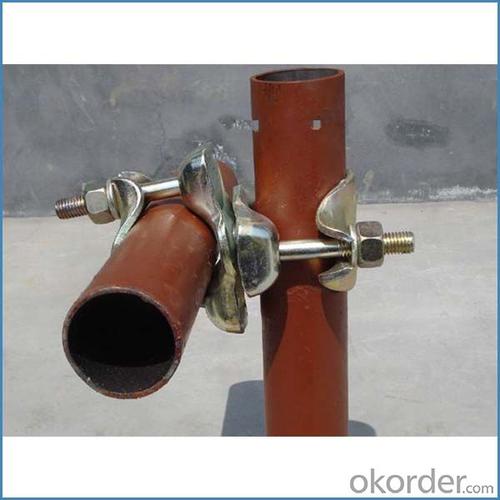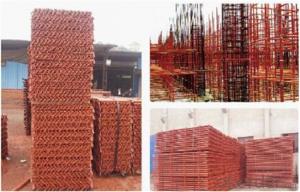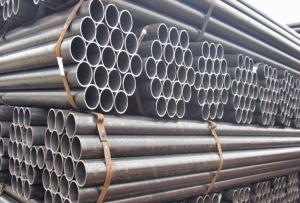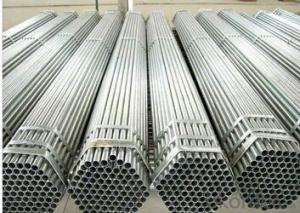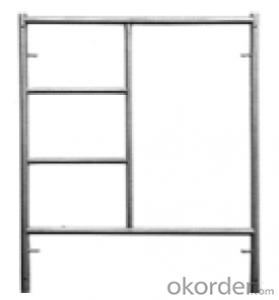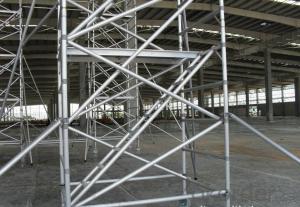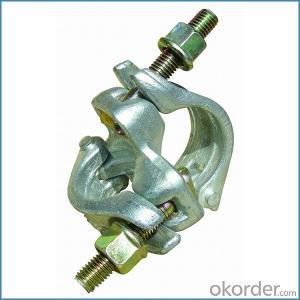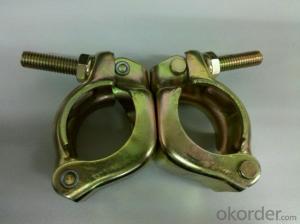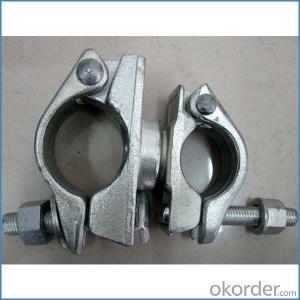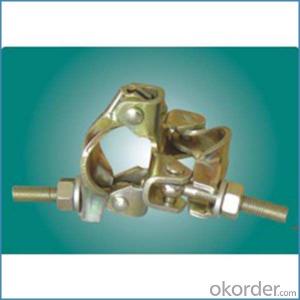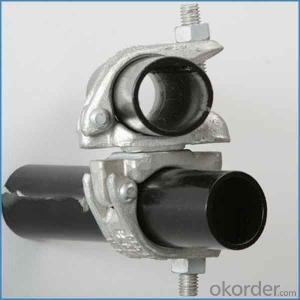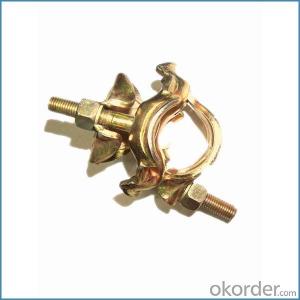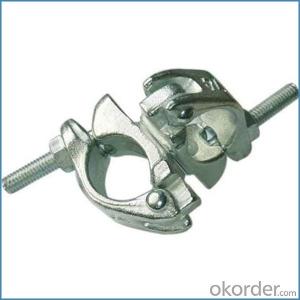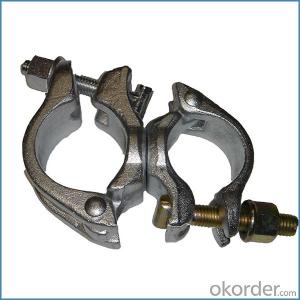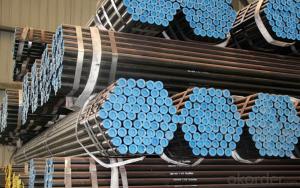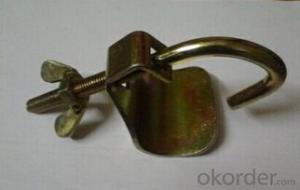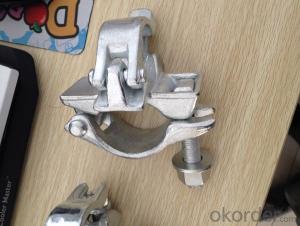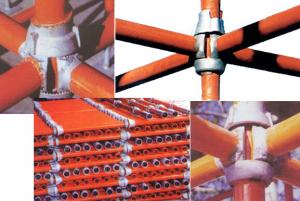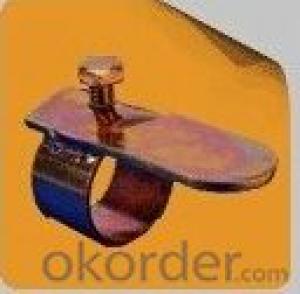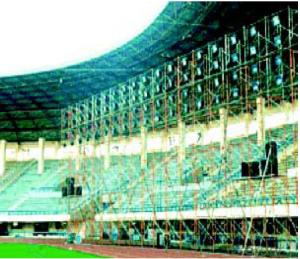American Type for Sale Double Coupler British Type for Sale
- Loading Port:
- Tianjin
- Payment Terms:
- TT OR LC
- Min Order Qty:
- 1000 kg
- Supply Capability:
- 100000 kg/month
OKorder Service Pledge
OKorder Financial Service
You Might Also Like
American Type for Sale Double Coupler British Type for Sale
Description
1.The scaffolding coupler is always used to connect the steel pipe as scaffolding system.
2.The often used coupler is swivel coupler and righ angle coupler .
3.We can provide types of scaffolding coupler according to your requirement.
4.Couoler can fix the 48.3mm scaffolding steel pipe tightly and make the whole scaffolding system more steadily.
5.Material:Q235 steel
6.Overall Size:48.3mm*48.3mm
7.Surface Finish: Galvanized/ Painted
8.Standard:BS1139,EN74
9.Package:25pcs/bag
10.Manufactuering as per customer requirements
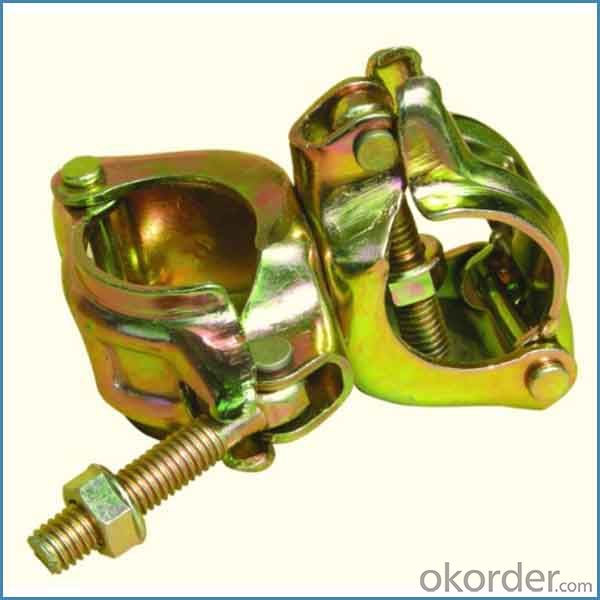
Feature
(1)Excellent Anti-Breaking—Cold Pressed Steel
(2)Outstanding Resistance Deformation
(3)Strong Anti-Dropping Ability
(4)Longtime USe
(5)Qualtity Guaranteed
(6)OEM Service
Photo
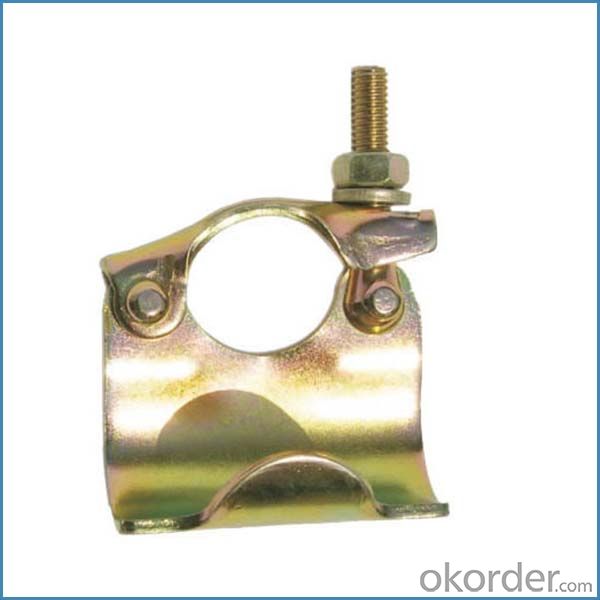
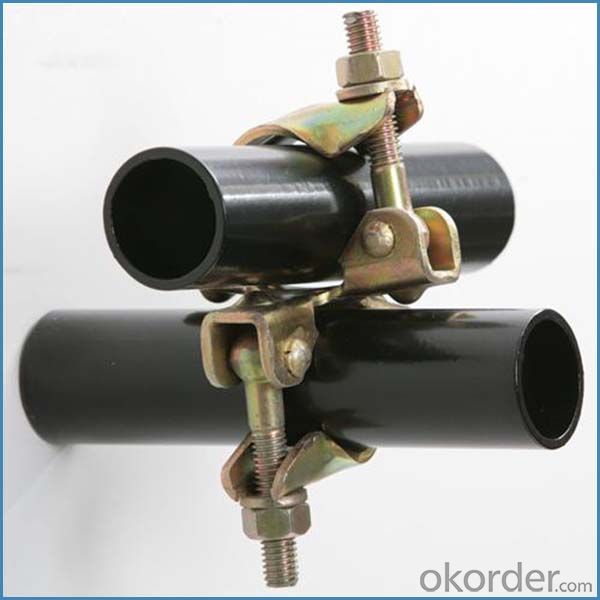
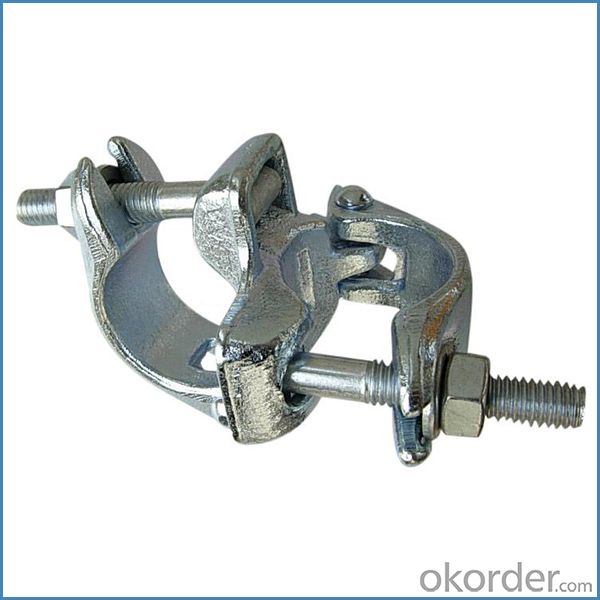
Parameter
| Material | Q235,345steel |
| Size | 48.3mm*48.3mm |
| Surface finish | Galvanized |
| Weight | 1.1kg around |
| Standard | BS1139,EN74 |
| Package | 25pcs/bag,steel pallet |
| Manufacture | As per customer requirement |
| Market | Africa, South America, the Middle East and Asia |
FAQ
Q: Are you a factory or trading company?
We are a state-owned corporation in China,dealing with various kinds of building materials.We have our holding subsidiaries.
Q: Where is your factory located? How can I visit there?
Our factory is located all around China.
Q: Can I get some samples?
Sample is free, customer only pay freight for the first time.
Q: Delivery?
10-30days. (5-15 containers)
Any question,feel free to contact us.
- Q: What are the common applications or industries that utilize steel tube couplers in scaffolding?
- The common applications or industries that utilize steel tube couplers in scaffolding include construction, building maintenance, shipbuilding, event management, and industrial maintenance. These industries rely on steel tube couplers to securely connect scaffolding tubes, ensuring the stability and safety of temporary structures used for various purposes like construction projects, maintenance work, or event setups.
- Q: What are the common safety precautions or guidelines for using steel tube couplers?
- To ensure safe operations when utilizing steel tube couplers, it is imperative to adhere to several standard safety precautions and guidelines. These precautions and guidelines encompass the following: 1. Correct Installation: The correct installation of steel tube couplers is of utmost importance. It is crucial to meticulously follow the manufacturer's instructions and guidelines. This entails ensuring that the couplers are firmly secured to the tubes and employing appropriate tools for installation. 2. Regular Inspection: Consistently inspect the couplers for any indications of wear, damage, or corrosion. If any issues are observed, it is imperative to promptly replace the couplers to prevent potential failures. 3. Load Capacity: Always take into consideration the load capacity of the steel tube couplers and ensure that they are not overloaded. Overstepping the recommended load capacity can result in structural failures and accidents. 4. Compatibility: Verify that the couplers are compatible with the specific size and type of steel tubes being utilized. Utilizing incompatible couplers can jeopardize the integrity of the structure and pose safety hazards. 5. Protective Gear: When engaging with steel tube couplers, it is essential to don suitable personal protective equipment (PPE) such as safety gloves and goggles. This aids in preventing injuries caused by sharp edges or airborne debris during installation or removal. 6. Proper Handling: Handle the steel tube couplers with caution to avoid dropping or mishandling, as this can lead to damage or deformations. Employ lifting equipment or techniques appropriate for the weight and size of the couplers to minimize the risk of accidents. 7. Secure Connections: Assure that the connections between the steel tubes and couplers are secure. Loose connections can induce instability and potential collapses, thus it is vital to verify and tighten the connections as necessary. 8. Training and Awareness: Adequate training and awareness of safety guidelines are essential for all individuals involved in utilizing steel tube couplers. This encompasses comprehending the risks, procedures, and best practices to ensure safe operations. By adhering to these prevalent safety precautions and guidelines, the risk of accidents, injuries, and structural failures associated with steel tube couplers can be significantly mitigated, fostering a secure working environment.
- Q: Can steel tube couplers be used to connect diagonal braces in scaffolding?
- Indeed, it is possible to utilize steel tube couplers for the purpose of connecting diagonal braces in scaffolding. These couplers are regularly employed within the realm of scaffolding construction to effectively link various components, including diagonal braces. By doing so, these couplers establish a sturdy and dependable connection between the tubes, guaranteeing stability and safety in the scaffolding structure. Their design facilitates easy installation and removal, thus enabling flexibility and adaptability within the scaffolding system. All in all, steel tube couplers emerge as a practical and trustworthy solution for connecting diagonal braces in scaffolding.
- Q: Do steel tube couplers have any specific safety certifications or approvals?
- Yes, steel tube couplers typically have specific safety certifications and approvals. These certifications ensure that the couplers meet certain safety standards and can be safely used in construction and other applications. Some common certifications include ISO 9001 for quality management and ISO 14001 for environmental management. Additionally, couplers may also comply with specific industry standards such as British Standards (BS) or American Society for Testing and Materials (ASTM) to ensure their safety and performance.
- Q: How do you inspect steel tube couplers for any defects or damage?
- To ensure the absence of defects or damage in steel tube couplers, a systematic and detail-oriented approach is required. The following steps outline the process of inspecting steel tube couplers: 1. Conduct a visual inspection: Begin by visually examining the coupler for any visible defects or damage. Look out for cracks, fractures, dents, or deformations. Additionally, pay attention to the surface condition, as rust or corrosion may indicate potential issues. 2. Clean the coupler: Before proceeding with further inspection, clean the coupler using an appropriate cleaning agent to eliminate any dirt, grease, or debris that could hinder the inspection process. This will provide a clear view of the coupler's surface. 3. Implement Non-Destructive Testing (NDT): Employing various NDT techniques can offer a more comprehensive inspection. Common NDT methods include magnetic particle testing (MT), liquid penetrant testing (PT), ultrasonic testing (UT), and radiographic testing (RT). These techniques are capable of detecting cracks, internal defects, or irregularities that may not be visible to the naked eye. 4. Perform dimensional inspection: Precise measurements are crucial in assessing the integrity of steel tube couplers. Utilize precision measuring tools such as calipers, micrometers, or gauges to check dimensions such as inner and outer diameters, length, and thickness. Compare these measurements against the manufacturer's specifications. 5. Verify load capacity: Steel tube couplers are designed to withstand specific loads. Confirm that the coupler's load capacity aligns with the intended application. Additionally, ensure that the coupler has not been exposed to excessive loads or damage that could compromise its strength. 6. Document the findings: Record all inspection findings, including any defects or damage encountered during the process. This documentation serves as a future reference and aids in proper record-keeping. It is important to emphasize that the inspection of steel tube couplers should ideally be carried out by experienced personnel who possess knowledge of coupler specifications and inspection techniques. Regular inspections and maintenance are necessary to guarantee the safe and reliable performance of steel tube couplers.
- Q: What are the common warranty terms for steel tube couplers?
- The common warranty terms for steel tube couplers typically range from 1 to 5 years, depending on the manufacturer and the specific product.
- Q: What is the minimum spacing between the crossbar and the pole spacing of the scaffold?
- According to JGJ130-2011 "construction of fastener type steel pipe scaffold safety technical specifications" is just that should not exceed 50 meters. Did not explain the restrictions on workers to shelve construction. May be specific to a more specific program scaffolding calculation book to calculate. Should be and step, span, even wall pieces, scissors, and other specific size settings associated.
- Q: Are there any specific regulations or guidelines for using steel tube couplers in scaffolding?
- The use of steel tube couplers in scaffolding is subject to specific regulations and guidelines, which aim to ensure the safety and stability of the scaffold structure. These regulations and guidelines are set by national standards or codes of practice in most countries. National standards provide requirements for the design, construction, and installation of scaffolding systems that use steel tube couplers. They also offer guidance on the types of couplers that are suitable, their load-bearing capacity, and the correct methods for connecting tubes using couplers. Several important regulations and guidelines govern the use of steel tube couplers in scaffolding: 1. Load-bearing capacity: Couplers must be able to withstand the expected loads and forces exerted on the scaffold, including the weight of workers, equipment, and materials. The manufacturer should clearly indicate the load-bearing capacity of the couplers. 2. Proper installation: Couplers must be installed correctly according to the manufacturer's instructions and the relevant standards. This involves securely tightening the couplers and ensuring proper alignment and connection of the tubes. 3. Compatibility: Couplers used in the scaffolding system must be compatible with the specific type and size of tubes being used. Mixing different types or sizes of tubes and couplers could compromise the structural integrity of the scaffold. 4. Inspection and maintenance: Regular inspection and maintenance of the steel tube couplers are necessary to ensure their ongoing safety and functionality. Visual inspections should be conducted to identify any signs of damage, wear, or corrosion. Any defective couplers should be replaced immediately. 5. Training and competence: Scaffold erectors and users should receive adequate training to understand the regulations and guidelines for using steel tube couplers. They should also be able to identify and address any potential safety risks associated with coupler usage. It is important to consult the specific regulations and guidelines applicable to your jurisdiction, as they may differ. Seeking advice from a qualified engineer or scaffolding professional is recommended for specific guidance on using steel tube couplers in scaffolding.
- Q: Can steel tube couplers be used for scaffolding structures that require frequent modifications?
- Certainly, scaffolding structures that necessitate frequent modifications can utilize steel tube couplers. Due to their versatility, strength, and ease of use, steel tube couplers are commonly employed in scaffolding systems. These couplers facilitate the connection of steel tubes at various angles and positions, enabling the creation of customized scaffolding structures tailored to specific requirements. An advantageous feature of steel tube couplers is their capability to establish a secure and stable connection between steel tubes, ensuring the scaffolding structure's durability and dependability. Moreover, these couplers are designed to be easily adjustable, allowing for swift modifications and alterations to the scaffolding layout as required. In industries such as construction or events where scaffolding structures necessitate frequent modifications, the ability to adapt and reconfigure the scaffolding promptly is vital. Steel tube couplers provide a flexible solution that permits efficient changes to the scaffolding design without compromising its stability or safety. Additionally, steel tube couplers are reusable, further enhancing their suitability for scaffolding structures that require frequent modifications. They can be effortlessly detached and reattached to different steel tubes, eliminating the need for constant replacement or additional materials. Overall, steel tube couplers are an exceptional option for scaffolding structures that necessitate regular adjustments. They provide a robust and secure connection, enable quick modifications, and offer reusability, making them a practical and efficient solution for scaffolding systems requiring frequent changes.
- Q: How do steel tube couplers ensure the levelness and alignment of scaffolding platforms?
- Steel tube couplers ensure the levelness and alignment of scaffolding platforms by securely connecting the tubes together at right angles. These couplers are designed to provide a strong and stable connection, preventing any movement or shifting of the tubes. This ensures that the platforms remain level and aligned, providing a safe working surface for workers on the scaffolding.
Send your message to us
American Type for Sale Double Coupler British Type for Sale
- Loading Port:
- Tianjin
- Payment Terms:
- TT OR LC
- Min Order Qty:
- 1000 kg
- Supply Capability:
- 100000 kg/month
OKorder Service Pledge
OKorder Financial Service
Similar products
Hot products
Hot Searches



